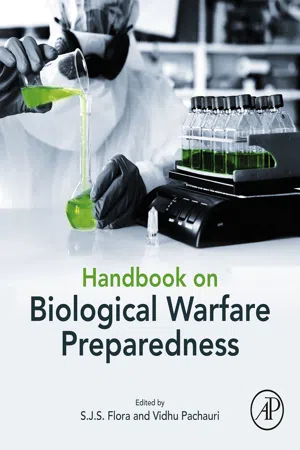
- 306 pages
- English
- ePUB (mobile friendly)
- Available on iOS & Android
Handbook on Biological Warfare Preparedness
About This Book
Handbook on Biological Warfare Preparedness provides detailed information on biological warfare agents and their mode of transmission and spread. In addition, it explains methods of detection and medical countermeasures, including vaccine and post-exposure therapeutics, with specific sections detailing diseases, their transmission, clinical signs and symptoms, diagnosis, treatment, vaccines, prevention and management. This book is useful reading for researchers and advanced students in toxicology, but it will also prove helpful for medical students, civil administration, medical doctors, first responders and security forces.
As the highly unpredictable nature of any event involving biological warfare agents has given rise to the need for the rapid development of accurate detection systems, this book is a timely resource on the topic.
- Introduces different bacterial and viral agents, including Ebola and other emerging threats and toxins
- Discusses medical countermeasures, including vaccines and post-exposure therapeutics
- Includes a comprehensive review of current methods of detection
Frequently asked questions
Information
Biological warfare agents: History and modern-day relevance
Abstract
Keywords
History of biological warfare agents
Table of contents
- Cover image
- Title page
- Table of Contents
- Copyright
- Dedication
- Contributors
- Preface
- Acknowledgments
- Chapter 1: Biological warfare agents: History and modern-day relevance
- Chapter 2: Bacterial biological warfare agents
- Chapter 3: Toxins as biological warfare agents
- Chapter 4: Viral agents including threat from emerging viral infections
- Chapter 5: Advance detection technologies for select biothreat agents
- Chapter 6: Microfluidics application for detection of biological warfare agents
- Chapter 7: Collection, storage, and transportation of samples for offsite analysis
- Chapter 8: Medical management of diseases associated with biological warfare
- Chapter 9: Protective equipment for protection against biological warfare agents
- Chapter 10: Environmental sampling and bio-decontamination—Recent progress, challenges, and future direction
- Chapter 11: Biological and toxin warfare convention: Current status and future prospects
- Chapter 12: Next generation agents (synthetic agents): Emerging threats and challenges in detection, protection, and decontamination
- Chapter 13: Genome information of BW agents and their application in biodefence
- Chapter 14: Planning for protection of civilians against bioterrorism
- Index